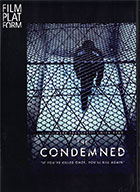
The Condemned 2013
Distributed by Film Platform
Produced by Mark Franchetti
Directed by Nick Read
DVD , color, 80 min., Russian with English subtitles
General Adult
Capital Punishment, Contemporary Russia, Criminal Justice, Incarceration
Date Entered: 11/13/2015
Reviewed by Andrew Jenks, California State University, Long BeachThe Condemned feeds a seemingly insatiable Western demand for stories about Russian cultures of violence and criminality. It tells the story of Russia’s most brutal and incorrigible prisoners, housed in Russia’s harshest prison – a place where winter temperatures hit 40 below and the nearest city is a seven-hour drive. The prison houses 260 prisoners, all of them murderers formerly on death row. They landed here when Russia eliminated capital punishment in 1996. To justify the elimination of capital punishment, those whose lives were spared were mandated to endure a prison regime far harsher than most, which in the Russian context is harsh indeed. No wonder, as one of the inmates notes, many previously on death row committed suicide rather than face the rest of their lives incarcerated. The most dangerous of the prisoners live alone in 5 square meter cells. They spend 23 hours in their cell and are allowed one hour in a cell that opens to the sky, steel bars on top. Guards look down upon them as they pace back and forth, like caged animals. During waking hours they are not permitted to lie on their bed.
The sounds of the prison are a kind of Chinese water torture for the prisoners: the clanging of doors, the jiggling of keys. For the “Lifers,” as they are known – and there are others in the prison communal barracks that apparently have some hope of release, though that point is not made clearly in the film – there is no pretense of rehabilitation. The prison is a purely punitive institution, with little hope of redemption outside the comfort of the bible and religion.
The documentary interviews the prison director and prisoners in various parts of the prison – those who live in solitary confinement as well as those who live in communal barracks, including the “downcasts,” usually pedophiles, who also perform sexual services for the other inmates. They are serial killers, pedophiles and murderers of children and women. Many show little remorse, while others agonize over a fate that brought them to such a hopeless and hapless point. Many came of age in the 1990s, when the Russian economy was in free fall. Desperate, they resorted to a life of crime to support themselves. The gangster culture of that time made life cheap, and they acquired a habit of violence and murder that eventually landed them on death row.
The warden of the prison has little sympathy for his charges. Society would be better off executing the prisoners, he says. His attitude, surprisingly, reflects the position of some prisoners: “If you’ve killed once, you’ll kill again,” says one. The story of one prisoner is especially chilling. He recounted how he abducted a woman, raped her, and then killed her. He hid her body in the forest. Later, after a fight, he landed in a hospital. At that point he summoned the police and confessed his crime, realizing that if he were to be free he would kill again.
Time flows at a different pace in prison. Free people, says one prisoner, frequently meet others and have different kinds of experiences, even if they think their lives are monotonous. Processing the information from those encounters and experiences, in the view of one interviewed inmate, slows time down for those on the outside. For the prisoners, however, time collapses and accelerates in direct proportion to the monotony of everyday life and the sameness of all experiences. Lacking new information to process, the prisoner retreats into an internal world, losing track of the days and often going insane.
Some hold out hope for release, writing letters to officials. The most agonizing part for those who dream of freedom is to see loved ones. Each inmate has the right to two visits each year for four hours each. Most prisoners, it seems, rarely get visits, in part because of the vast distances and isolation of the prison and in part because some prisoners have no one that would want to visit them. But for those who remain connected to loved ones the visit is both exhilarating and agonizing. One thoughtful and penitent inmate, who killed some fellow-partiers in a drunken rage, tried to find solace in philosophy and religion. He wanted to remain strong for his wife and son, who had traveled thousands of miles for the four-hour visit, their first in years. The encounter was heartbreaking for all sides and certainly, at least for this viewer, did not justify the warden’s view that all the inmates should have been executed.
The documentary provides a shocking view into the bleak and hopeless life of the Russian “Lifer.” It is long – 80 minutes – and more judicious editing could have eliminated some elements of repetition. The explanations in the documentary are also not entirely clear, especially regarding whether all the prisoners are “Lifers” and what, exactly, distinguishes those who live in communal barracks, with far more privileges, from those who live in isolation. Also unclear is whether the sentence for those on death row is for life or 25 years. Is 25 years considered a “life sentence”? Yet the compelling and often gruesome stories of the inmates, and of the life they must now all lead until they die, makes this nonetheless a fascinating, disturbing, and in parts mesmerizing film.